I have about 40 types of isopods. Here is brief profile of each:
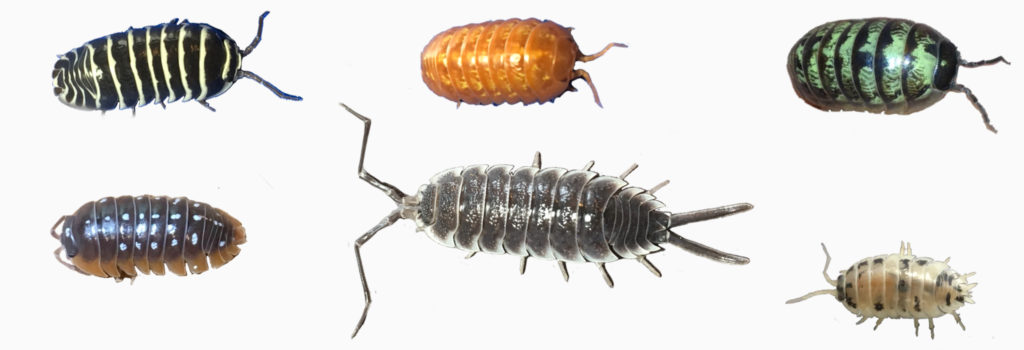
Armadillidium gestroi
This very strikingly marked species from France is thought to mimic a Glomeris pill millipede. This species may be one of my favorite Armadillidium species. It is very wide-bodied and large, and keeps its colors when it matures. It is not difficult to breed, but it takes a while to mature to a size at which it will breed. It seems to tolerate higher moisture levels than some other Armadillidium.
I cannot ship this species out of state.
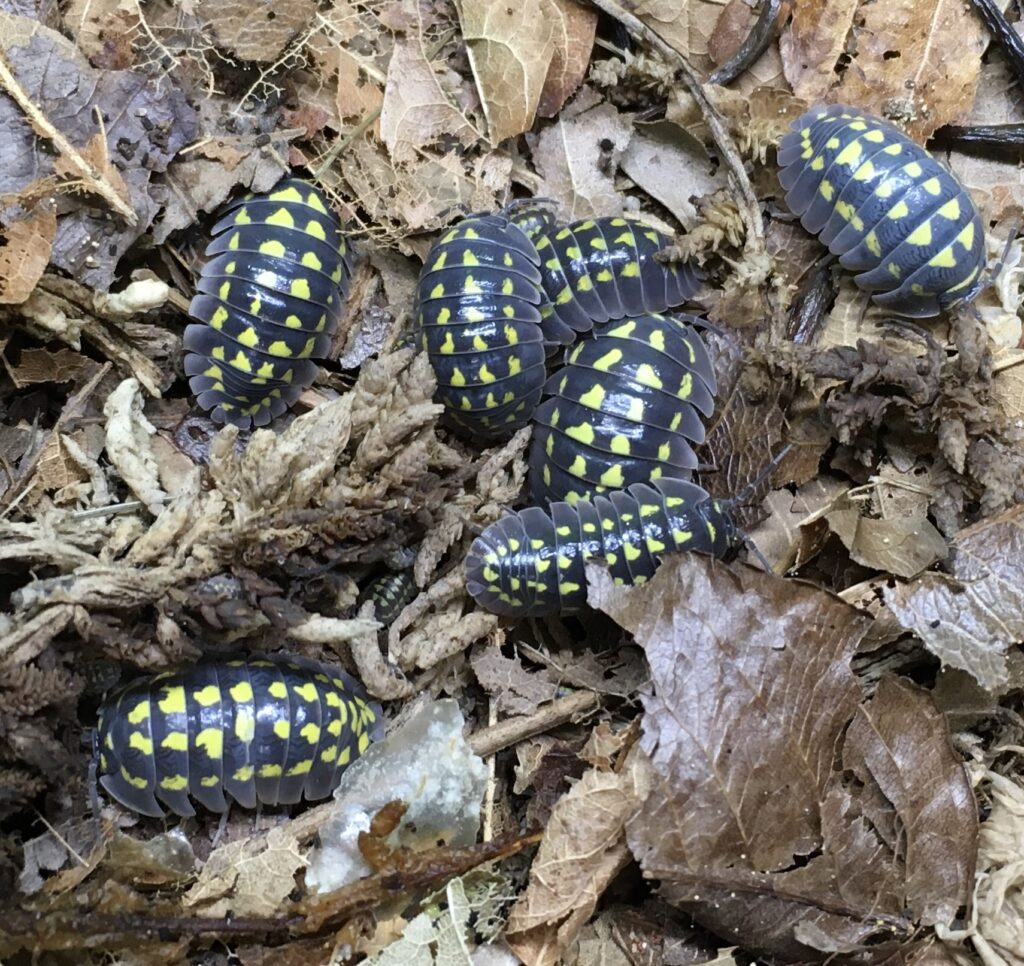
Armadillidium klugii ‘Dubrovnik Red Phase’
This locality features increased red markings across the back, and in some cases, is solid red with white spots.
Armadillidium klugii. ‘Montenegro’ (Clown Isopod)
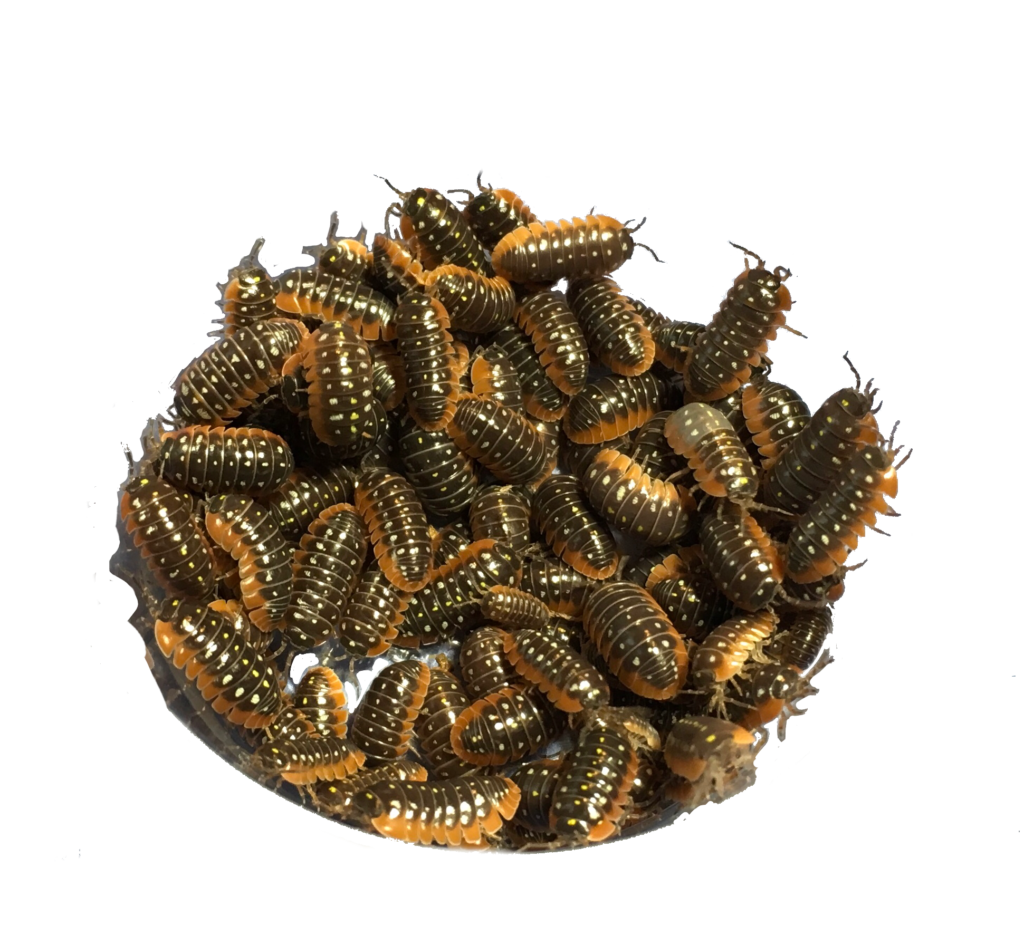
This is easily one of the most colorful isopods in the hobby. The vivid red-orange skirts and white and/or yellow spots have to be seen in person to be believed! Like other Armadillidium species, A. klugii prefers good ventilation, and A. klugii likes things on the dry side, although a moist hide is a necessity. This species is said to be very prolific at warm temperatures, and I do notice faster reproduction during the summer. This species also seems to appreciate more protein than some other isopods. This is not the easiest isopod to care for. I experienced a few die-offs early on, but once I stopped misting, and kept a very dry side and a mossy hydration station, they began to thrive.
Armadillidium nasatum ‘Peach’ (Peach Pillbug)
Armadillidium nasatum ‘whiteout’
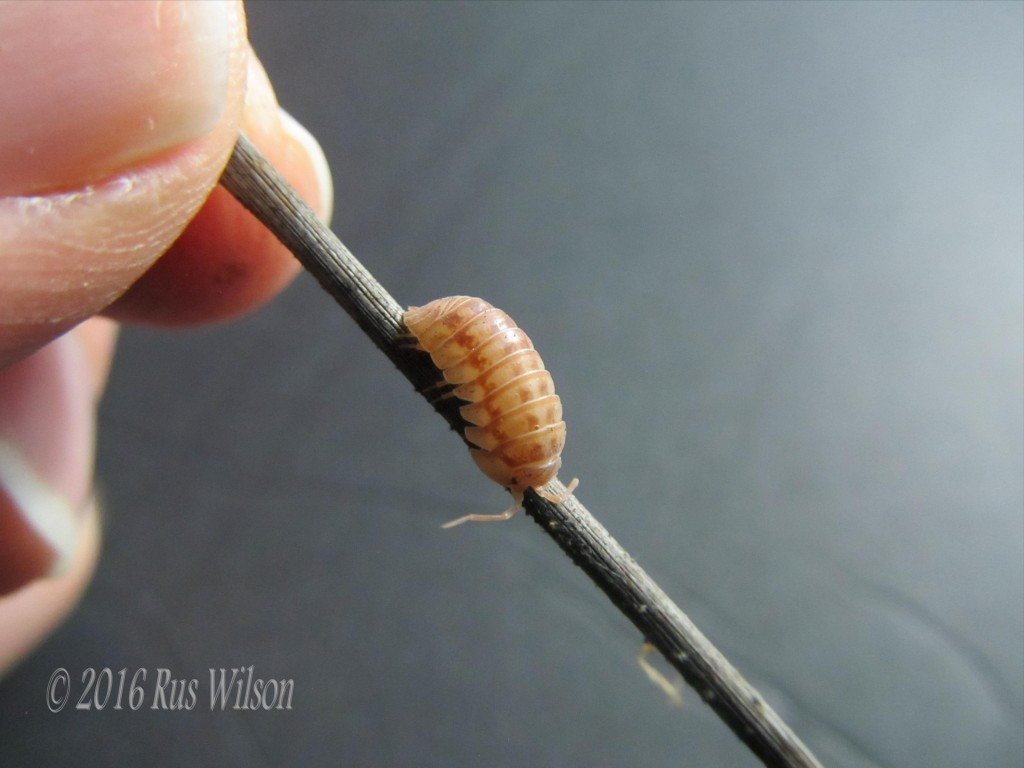
This peachy morph of A. nasatum is slightly smaller than A. vulgare. Its coloration is somewhat variable, some are quite a light peach color, while others are richer. Occasionally, a grayish wild-type even shows up. This species likes good ventilation, and needs a moist area to retreat to. It will congregate in large numbers under cork bark flats. This species is on the prolific side for Armadillidium, and has a hearty appetite.
Armadillidium maculatum (Zebra Pillbug)
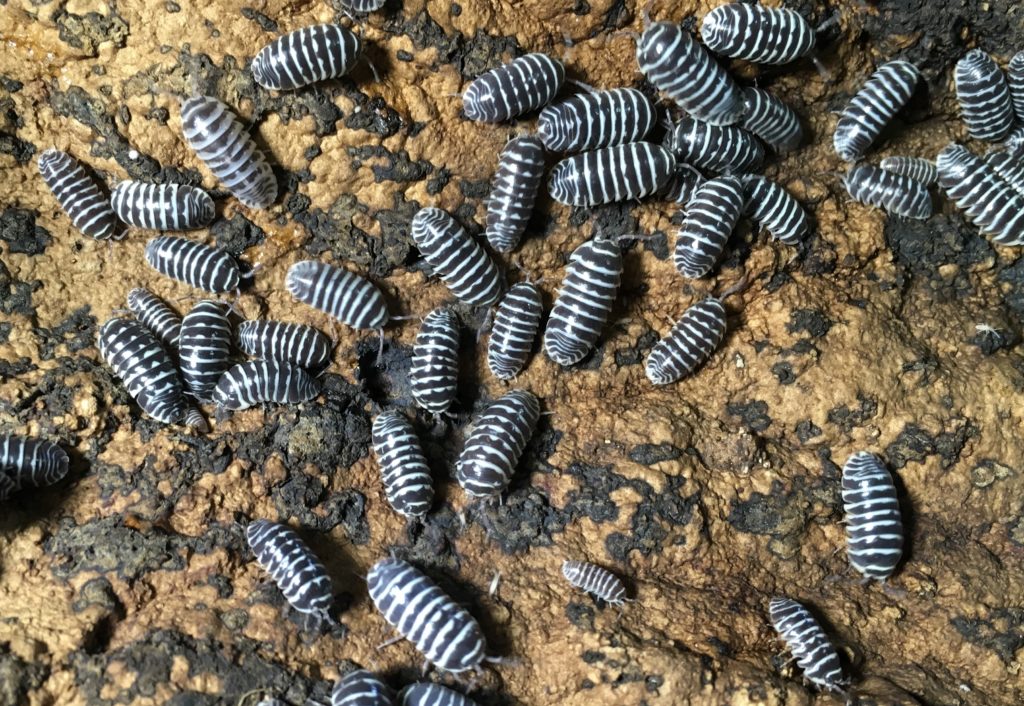
This is one of my all-time favorite isopods. Not only is the striped pattern beautiful, but the isopods are hardy and fairly prolific. These characteristics make them great hobby isopods. Zebra pillbugs appreciate good ventilation and can tolerate fairly dry substrate, as long as they have a damp spot to which they can retreat. I have used these as cleanup crew members in a leopard gecko enclosure.
Armadillidium vulgare ‘High Yellow’ (High Yellow Pillbug)
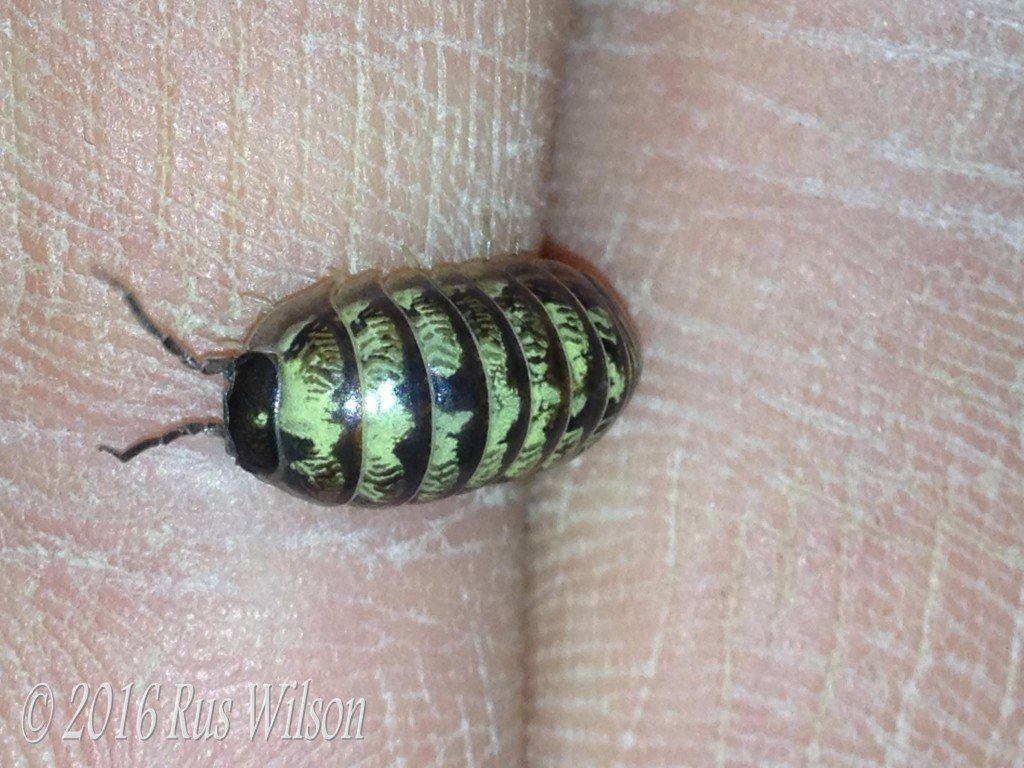
Female Armadillidium vulgare with yellow markings are common, but a few years ago, my son discovered a female A. vulgare with unusually high yellow. In the vicinity, we found several more that also had more yellow than normal, although not quite as highly marked as the one in the photo. We brought the colorful females and a few males home from the same locality, and several generations later, it appears that the coloration breeds true for the females. I have a good number of juveniles, and is am excited to see what they look like when they grow up!
Armadillidium vulgare ‘Orange Vigor’
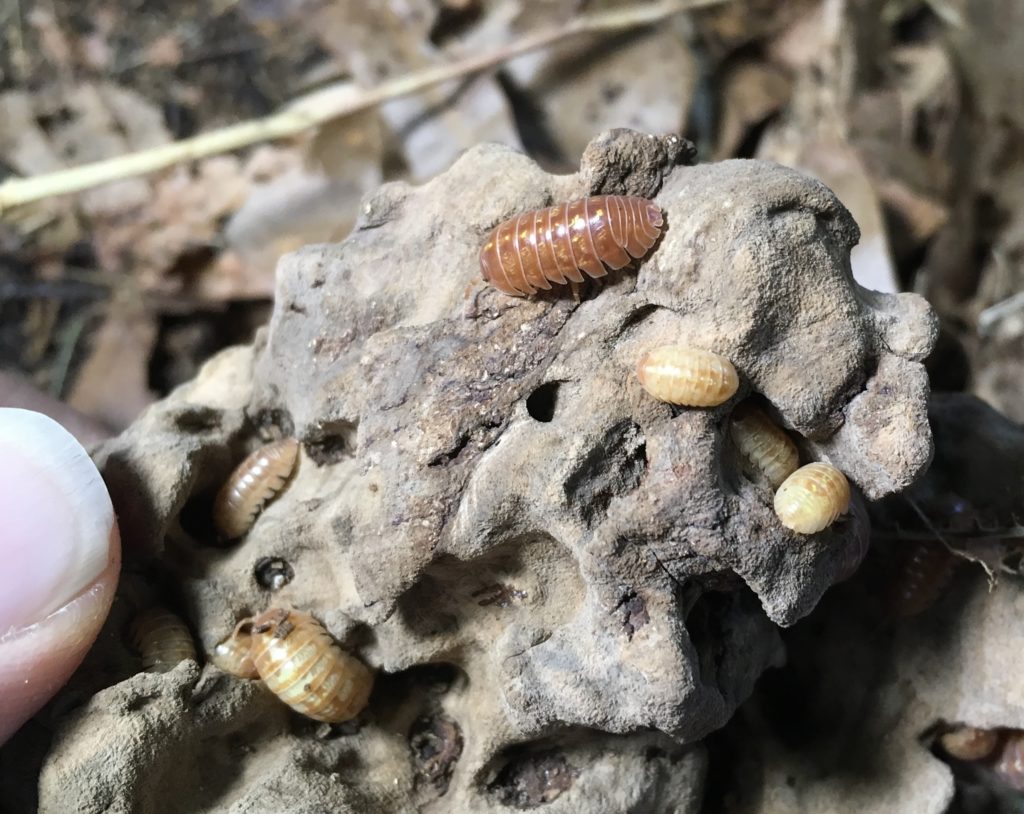
This beautifully colored morph of Armadillidium vulgare is aptly named: not only does it come in various shades of orange, but it is a very prolific strain, producing more quickly and more readily than any other Armadillidium vulgare strain I have kept. They prefer good ventilation and somewhat dry conditions, but need a damp retreat available at all times. Occasionally, this strain still throws wild types, but most are a beautiful orange, ranging from very light nearly yellow tone to to a rich, dark orange color.
Atlantoscia floridana (Florida Fast Isopod)
This species is quite a rapid mover for an isopod! They also breed quite quickly. They are a relatively small species that prefers moist habitats. These factors add up to make them a very good candidate for a cleanup crew in humid vivariums.
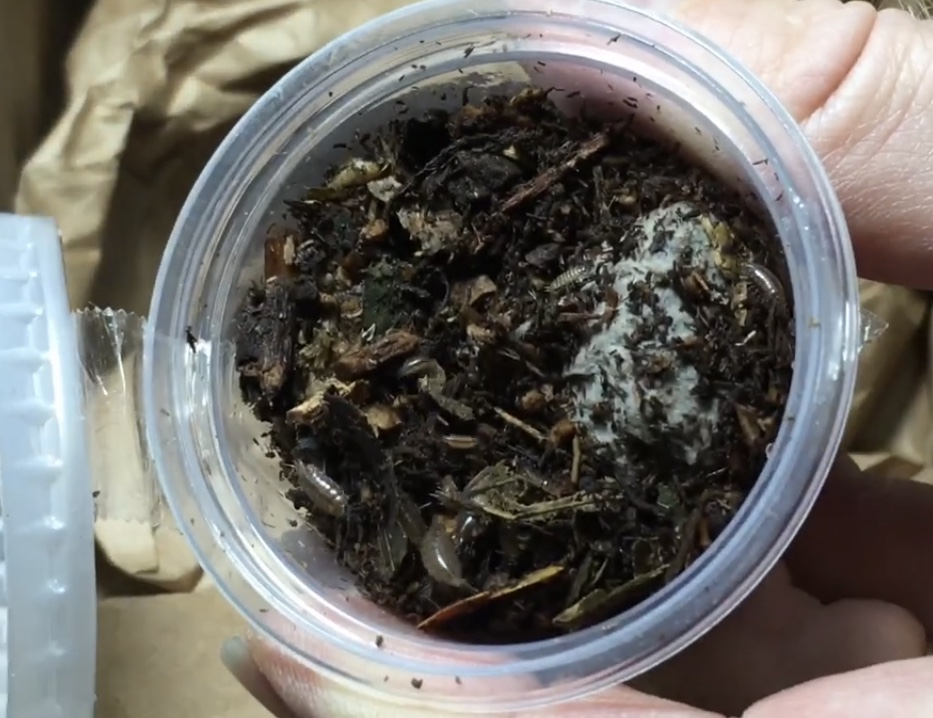
Cylisticus convexus (Curly or Teardrop Isopod)
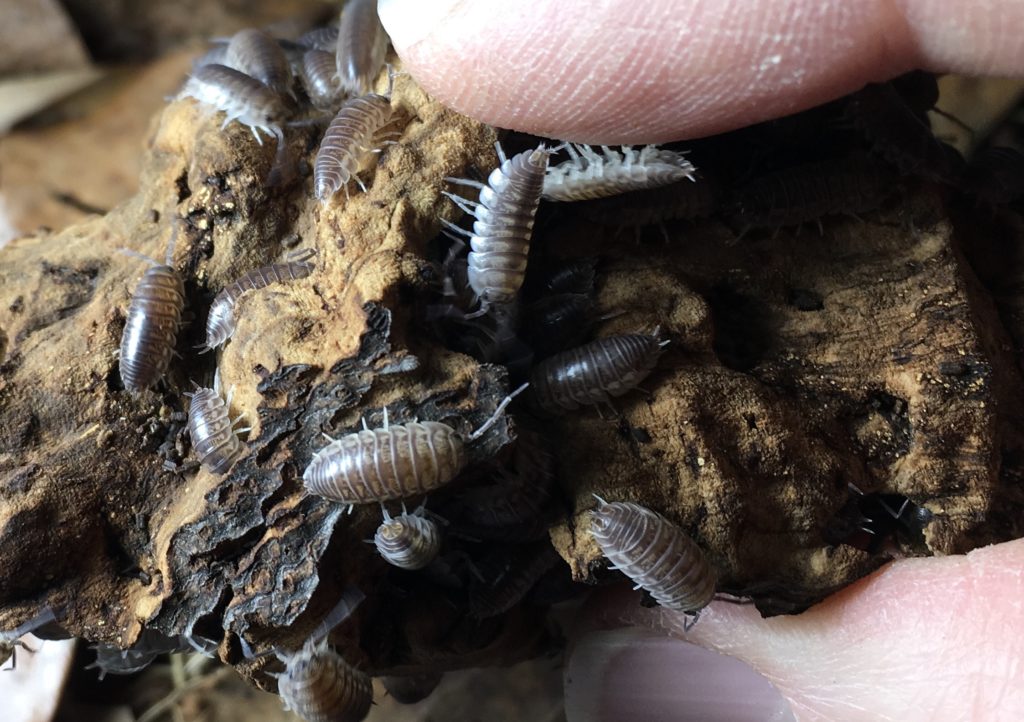
The Curly or Teardrop isopod is an underrated species…I believe they should be utilized more in cleanup crews in bioactive vivariums. They are fairly fast breeders and fast movers, and are more tolerant of low ventilation and high humidity than Armadillidium are. Interestingly, when they roll up, they form a slight teardrop shape, rather than a true sphere.
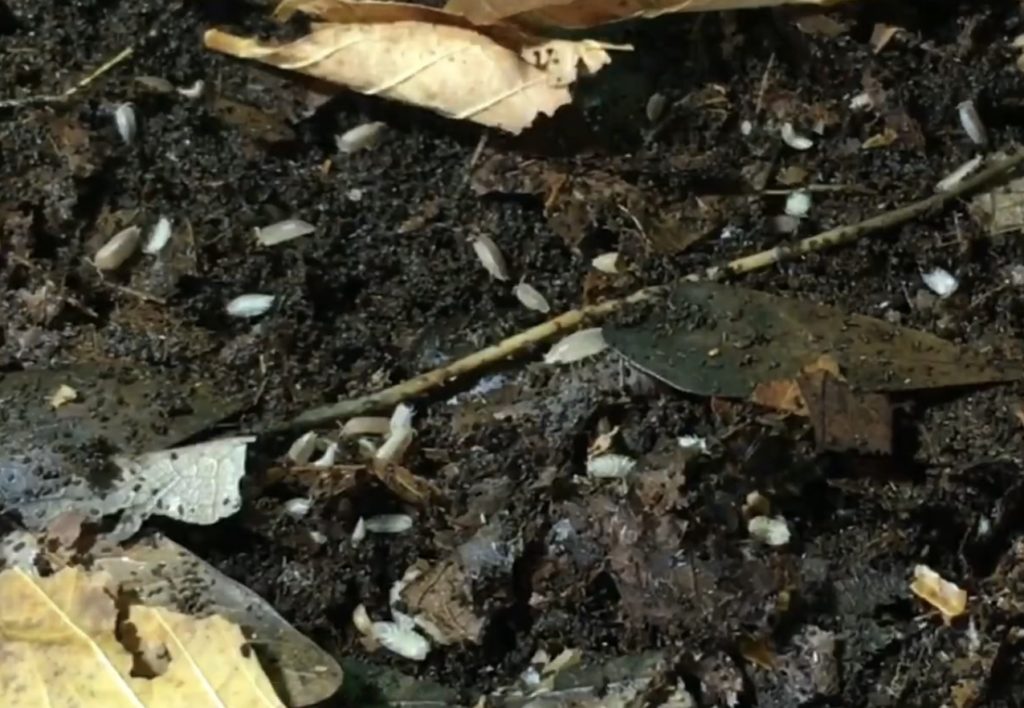
Nagurus cristatus (Dwarf Striped/Dwarf Gray Isopod)
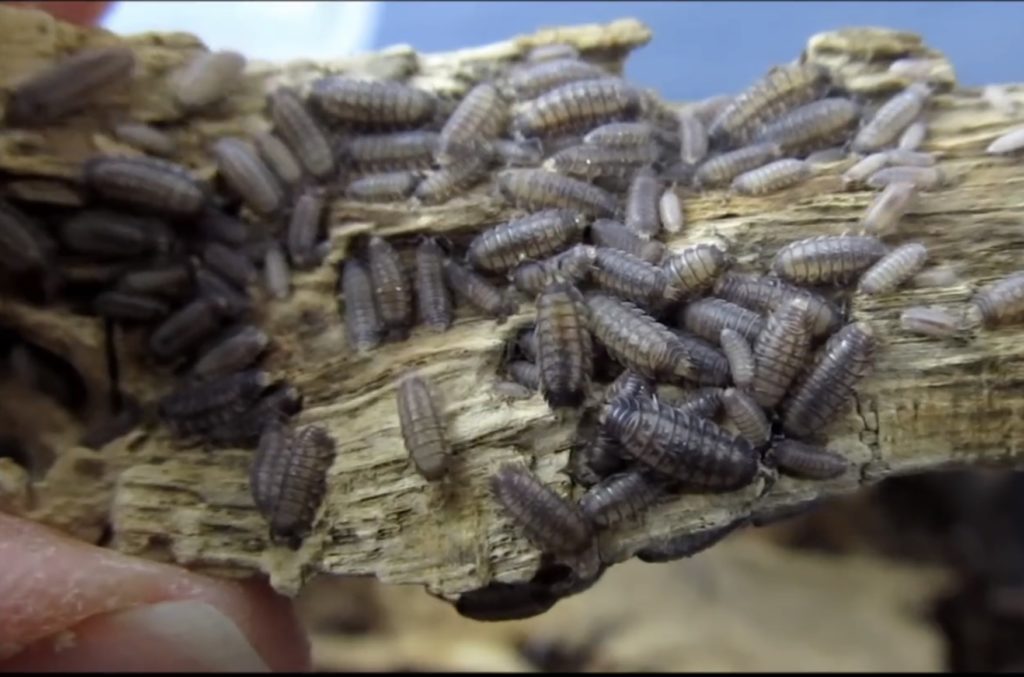
This species is quite small, but not quite as tiny as Trichorhina tomentosa or Trichoniscidae sp. ‘Jungle Micropod.’ Its is thought to reproduce through parthenogenesis…meaning it is an all-female species that produces genetic copies of itself. At first glance, this would seem to be a good species for a bioactive vivarium with dart frogs or small geckos in many respects, as I have found that it is one of the few that can thrive despite being preyed upon in such situations. However I have found this species to be inconsistent in its production. I once had a booming colony, which flourished for quite some time. It crashed for no apparent reason, and i have never had numbers like the original colony, though they haven’t died out completely either. Apparently, others have had similar problems with this species. Good ventilation seems to help somewhat. I can’t particularly recommend keeping N. cristatus until the reason for these die-offs can be explained and hopefully prevented.
Oniscus asellus (skirted Isopods)
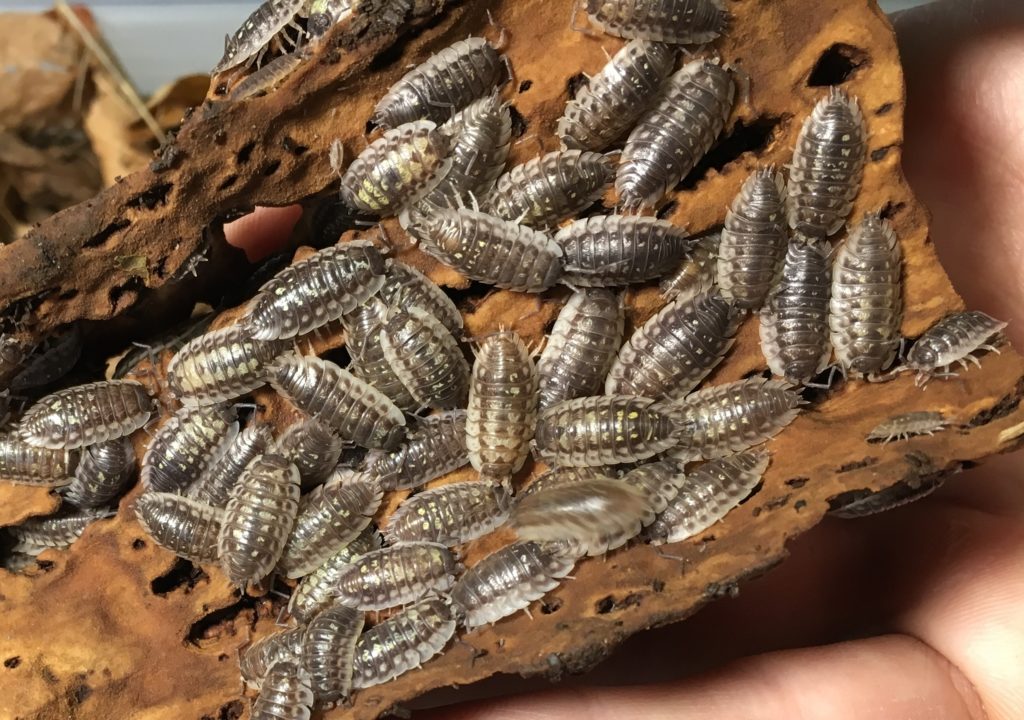
Skirted Isopods are a large species that really needs to be seen in person for its beauty to be fully appreciated. The almost metallic flecks on its dorsal surface are difficult to discern from a photo. This species prefers plenty of humidity and is content with minimal ventilation. It has a hearty appetite, and is moderately prolific. It is sometimes used as a cleanup crew species in very humid vivariums. Peter of Bugs in Cyberspace has mentioned that when he kept them with red-eyed tree frogs, the frogs would sometimes attempt to eat them, but them spit them out, likely do to their spiky ‘skirts’.
Porcellio dilatatus (Giant Canyon Sowbugs)
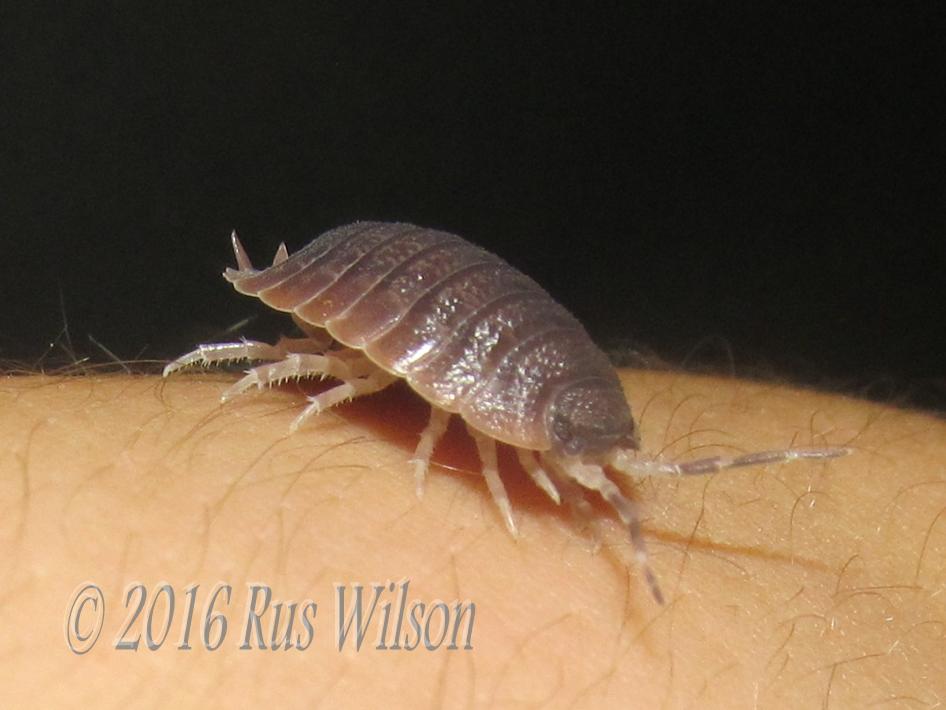
The Giant Canyon Isopod, Porcellio dilatatus, used to hold the title of largest isopod in the hobby. There are now plenty of much larger Spanish Porcellio species in the hobby that get much larger, but P. dilatatus is still a respectably large isopod, topping out at around 1 inch long. It looks even larger because of its wide, stocky build. This is a fairly prolific species, tolerant of varying levels of humidity and ventilation. It should always be offered a moist hide. This isopod has a hearty appetite, but is fairly secretive…they burrow very quickly when disturbed.
Porcellio expansus (Dragon or Beetlejuice Isopod)
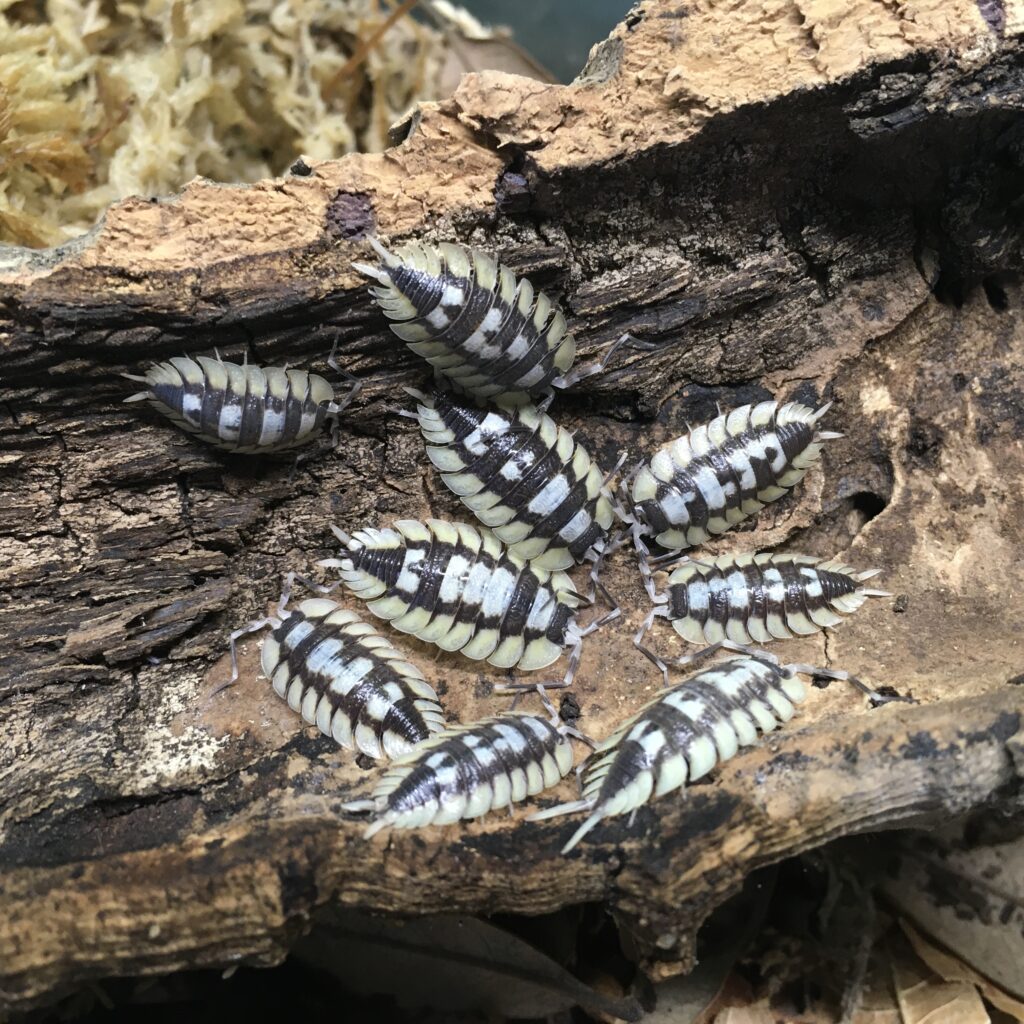
This large and fantastically marked Spanish species is a new one for me, but I hadn’t had them very long before they started to produce mancae. Like many of the Spanish Porcellio species, they require a strong gradient between moist and dry areas, as well as good ventilation.
Porcellio hoffmanseggi (Titans)
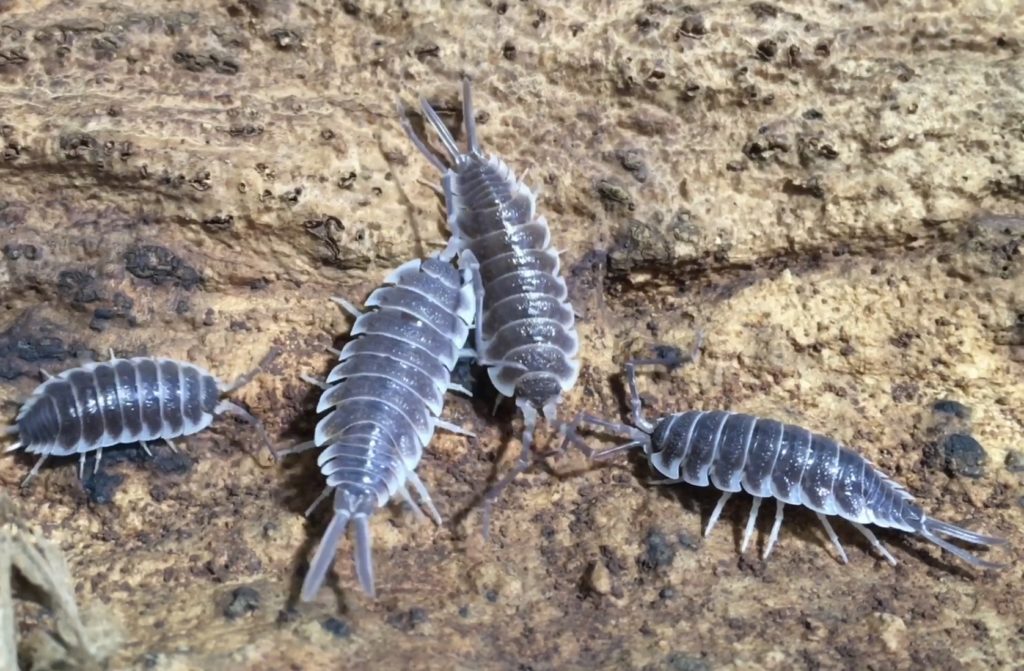
This species, endemic to Spain, is one of the largest fully terrestrial isopods in the hobby. Its elongate build, large antennae, and extended uropods of the male contribute to the impression of great size. In Porcellio hoffmanseggi, the female is considerably smaller than the male and lacks the extended uropods. This sexual dimorphism makes it easy to distinguish male from female, even though they both have very similar coloration. Like other giant Spanish isopods, P. hoffmannseggi does best with good ventilation, and a humidity gradient that allows them to seek damper or drier areas whenever needed. They are often known as ‘Titans’ or ‘Hoffs’ in the hobby.
Porcellio laevis ‘Dairy Cow’
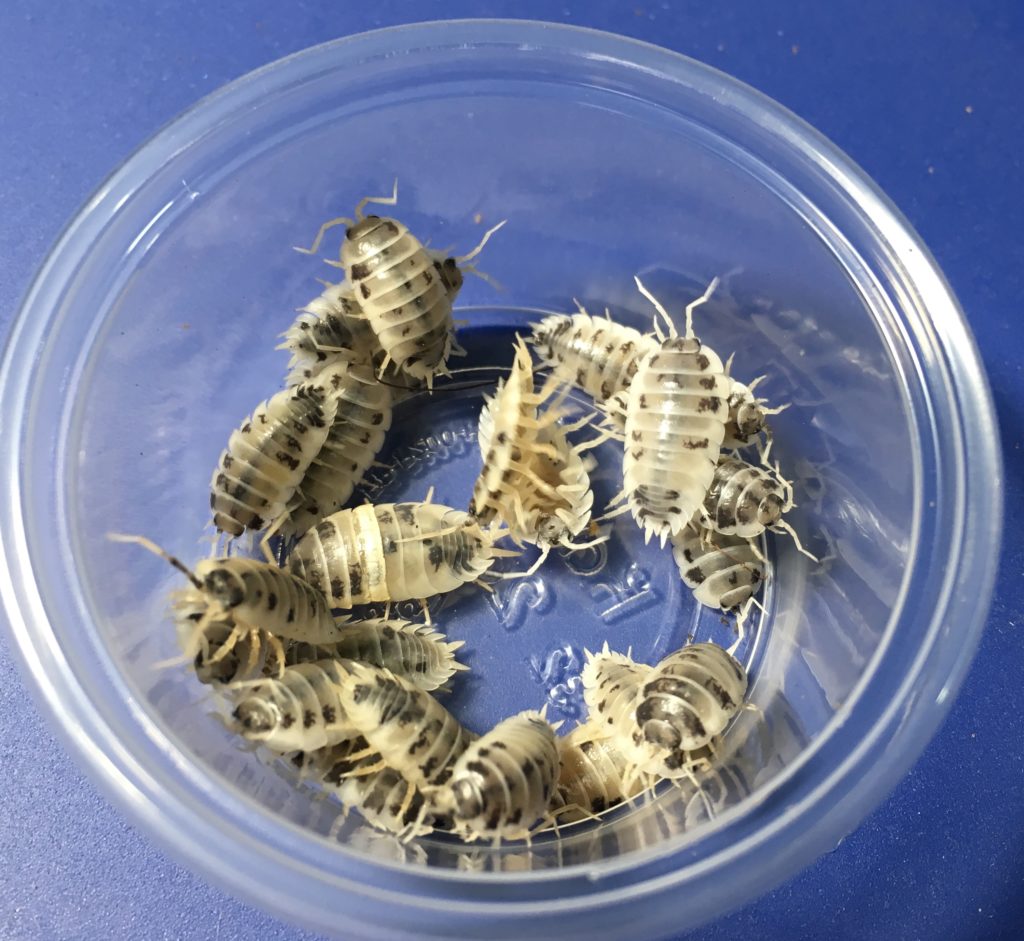
Porcellio laevis is a fairly large, fast-moving isopod. It reproduces quickly, and is more visible and active in its enclosure than many other species of isopod. The species name, laevis, means smooth, and is given in contrast to its close relative, P. scaber (scaber means ‘rough’. P. laevis not only has a smoother, shinier carapace than P. scaber, it is also larger and more prolific. This particular morph, ‘Dairy Cow,’ is so named for the random dark patches on a white or off-white body. Though the effect is similar to the ‘Dalmatian’ morph of Porcellio scaber, ‘Dairy Cow’ has a much cleaner look, which is partly due to the smoother, shinier exoskeleton, but also because the pattern appears more consistent, in P. scaber, some individuals are nearly all white with few if any dark marking, while P. laevis always seems to have a good distribution of dark markings on a light background. This species is quickly becoming one of my favorite isopods, for all of the reasons cited above. It is up for debate whether this is good candidate for a bioactive cleanup crew, as it craves protein and some feel it might attack molting arthropods or soft-bodied reptiles or amphibians. It likes a somewhat moist substrate.
Porcellio laevis ‘Milkback’
These are very similar to Dairy Cows in many respects. Some individuals are nearly identical to Dairy Cows, but many have a unique pattern, in which the central dorsal surface is pale, and the rest is dark. They may actually be a little larger and stockier than Dairy Cows.
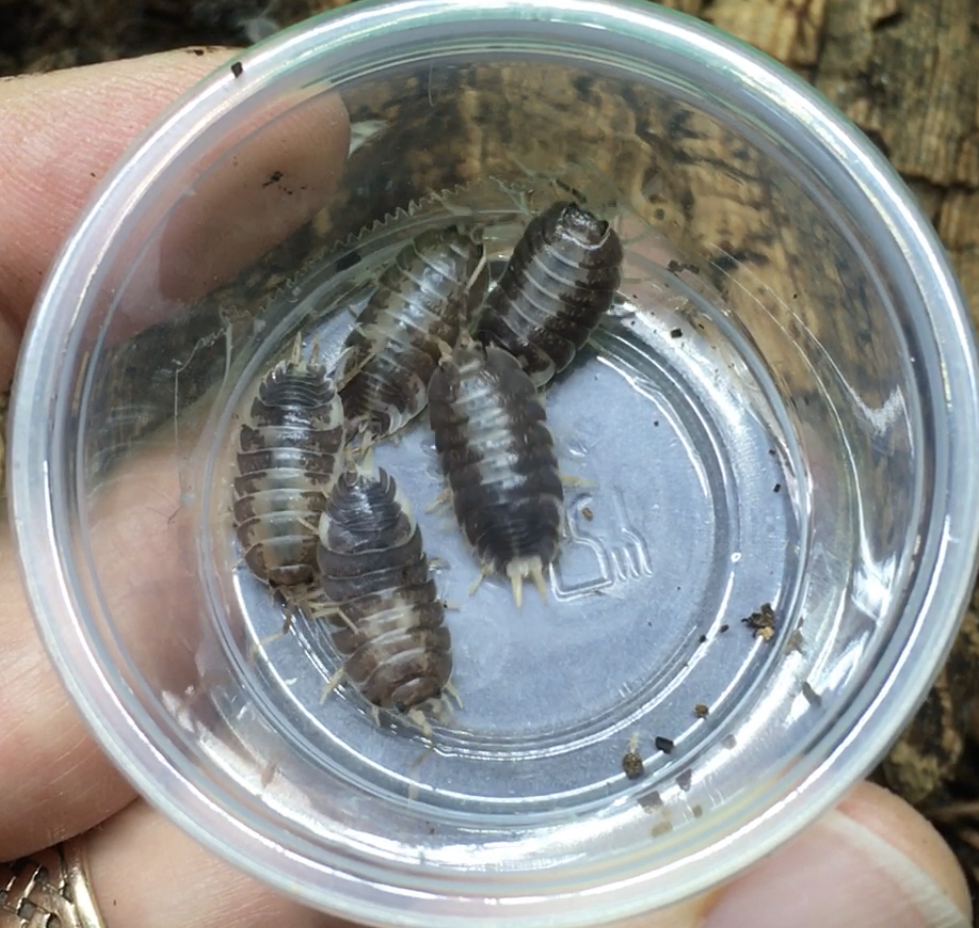
Porcellio laevis ‘Orange’
Porcellio laevis is a fairly large, fast-moving isopod. It reproduces quickly, and is more visible and active in its enclosure than many other species of isopod. The species name, laevis, means smooth, and is given in contrast to its close relative, P. scaber (scaber means ‘rough’. P. laevis not only has a smoother, shinier carapace than P. scaber, it is also larger and more prolific. This color morph, ‘Orange,’ is a more glossy, yet less rich, color than Orange specimens of its close cousin, Porcellio scaber. Porcellio laevis Orange seem to be less day-active than Dairy Cows or Milkbacks, and average slightly smaller. It likes a somewhat moist substrate.
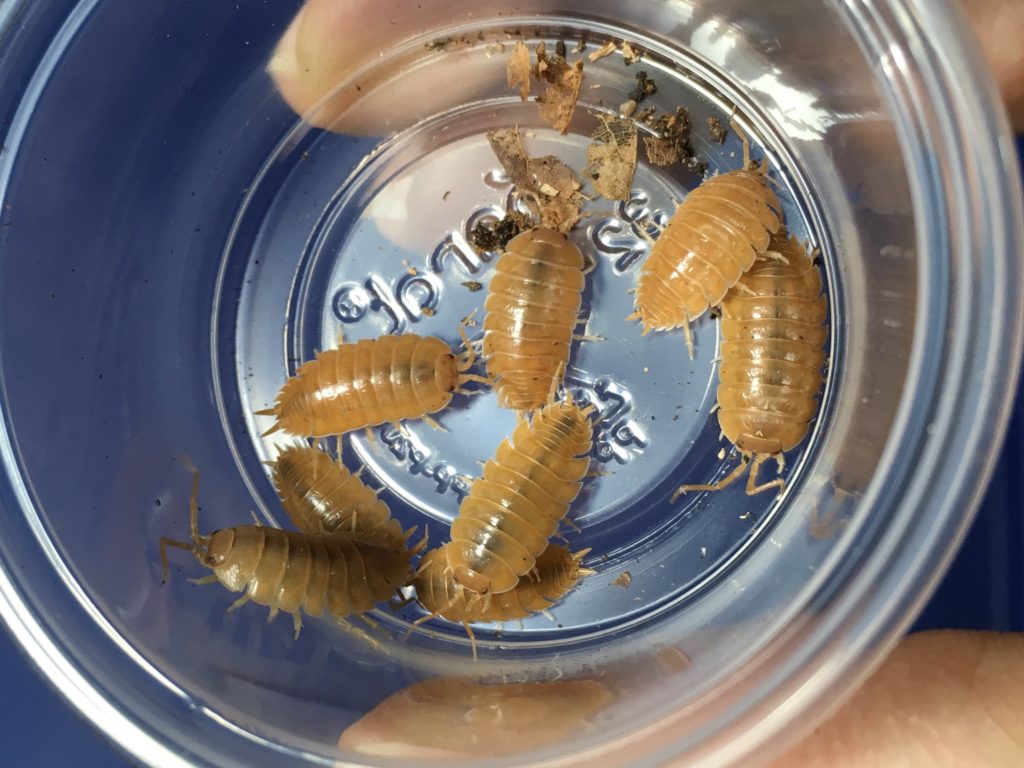
Porcellio magnificus
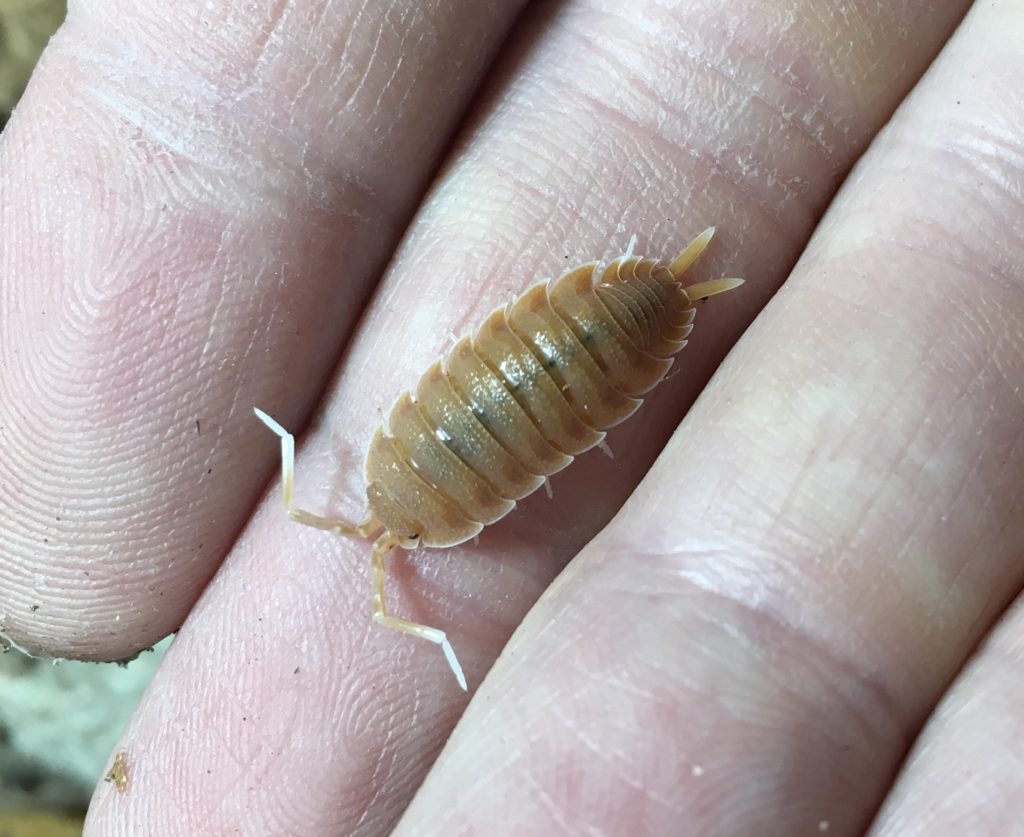
Porcellio magnificus is one of the largest isopods in the hobby, if not the largest. The one pictured is a juvenile with a lot of growing to do. The males have long uropods. Both the males and females have beautiful, thin, white skirting, as well as white-tipped antennae. Unlike most orange isopods, these are not a color morph…the species is naturally this lovely orange hue! In common with their giant Spanish Porcellio cousins, Porcellio magnificus prefers a mostly dry enclosure with a damp hide.
Porcellio ornatus ‘Yellow Dot’
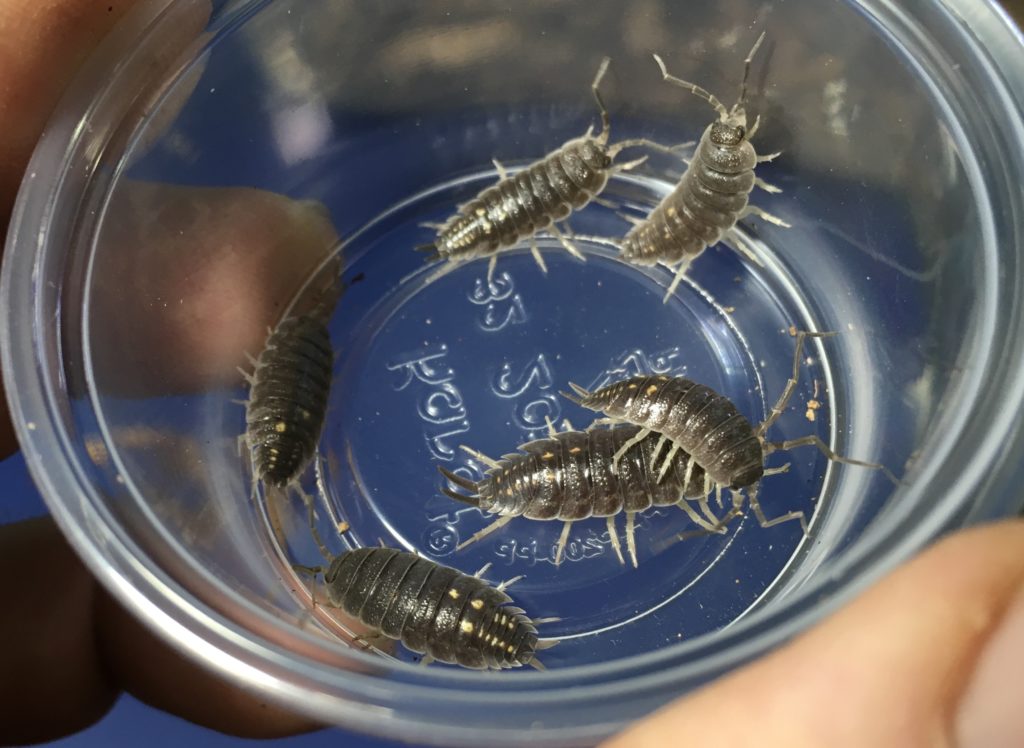
This is one of the hardiest and most prolific of the large Spanish Porcellio isopod species. There are several morphs available. This particular morph is mostly a dark gray color, but has some attractive, variable yellow markings on the terminal end of the carapace. It is an active species that likes to be kept just like other Spanish Porcellio species: plenty of ventilation with a moist hide, while the rest of the enclosure is kept fairly dry. These have a hearty appetite for protein, and will readily (though painlessly) nibble on your skin if they are hungry.
Porcellio scaber (Wild type)
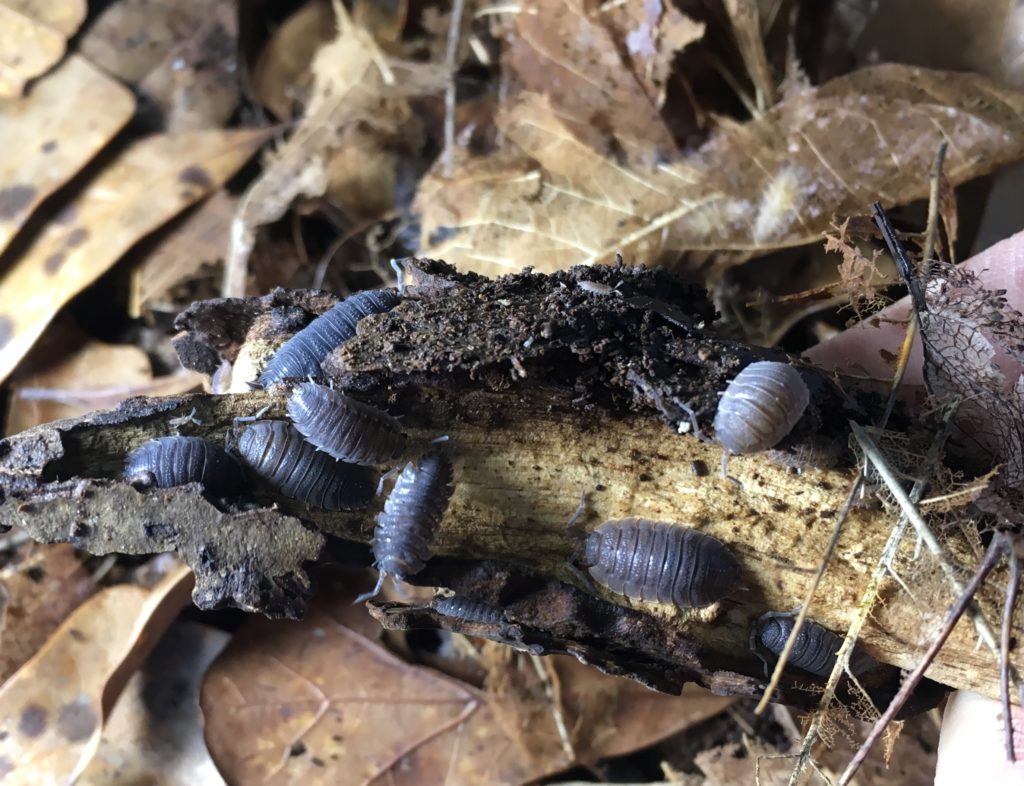
This is one of the most common garden-variety isopods, along with Armadillidium vulgare. The wild type is typically a uniform gray color, sometimes with a slightly lighter skirt. This species is tolerant of varying degrees of humidity and ventilation, but does require a moist hide at all times.
Porcellio scaber ‘Calico’
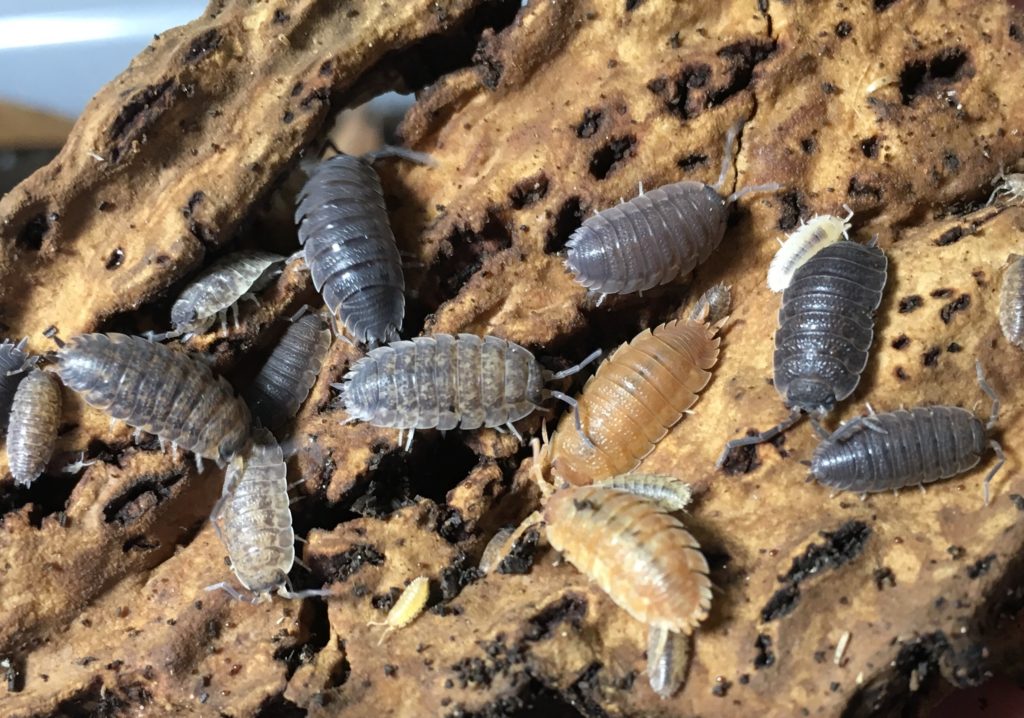
This interesting morph of Porcellio scaber is hardy and breeds fairly quickly. Its coloration is highly variable. Most of the males look like wild-type P. scaber, but the females can be Orange, yellowish, greenish, or mottled in varying patterns of mixed colors. Like all P. scaber morphs, it is tolerant of varying humidity and ventilation, but always requires a moist hide.
Porcellio scaber ‘Dalmatian’
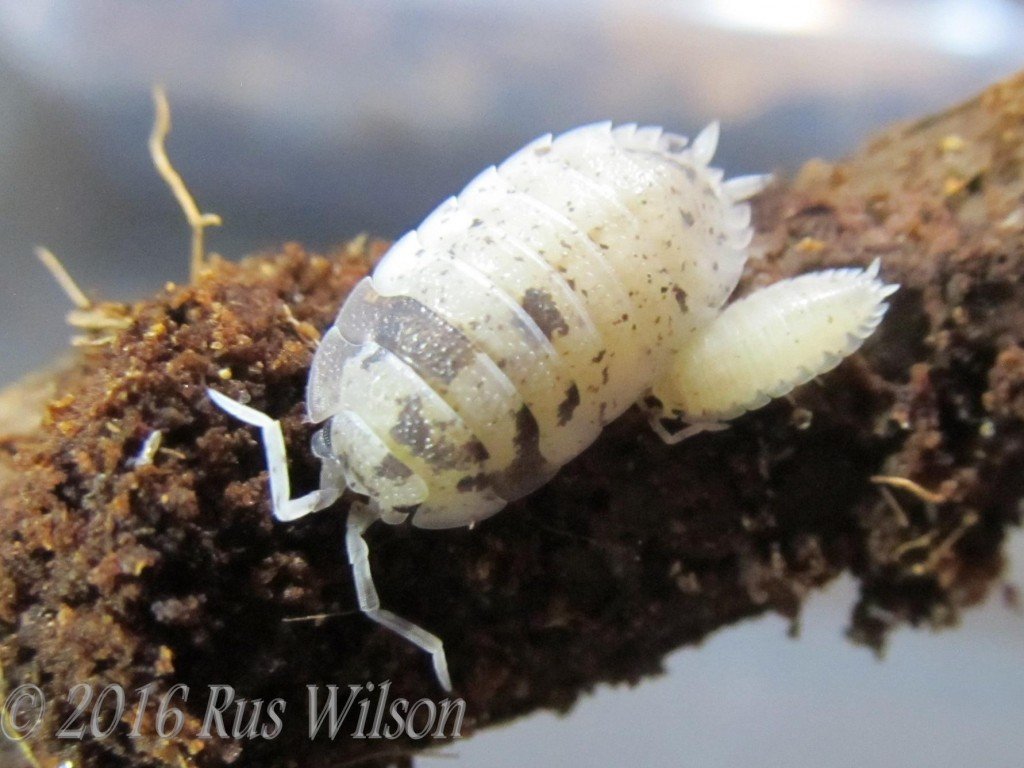
This morph of Porcellio scaber is named for the Dalmatian dog, due to its white background color with random spots and splotches of wild-type color. Some have dark splotches well-distributed on the body, while others have little gray pigment. This hardy morph is tolerant of varying levels of humidity and ventilation, but must have a moist hide available. It is moderately prolific, and generally has a hearty appetite.
Porcellio scaber ‘Morph Mix’
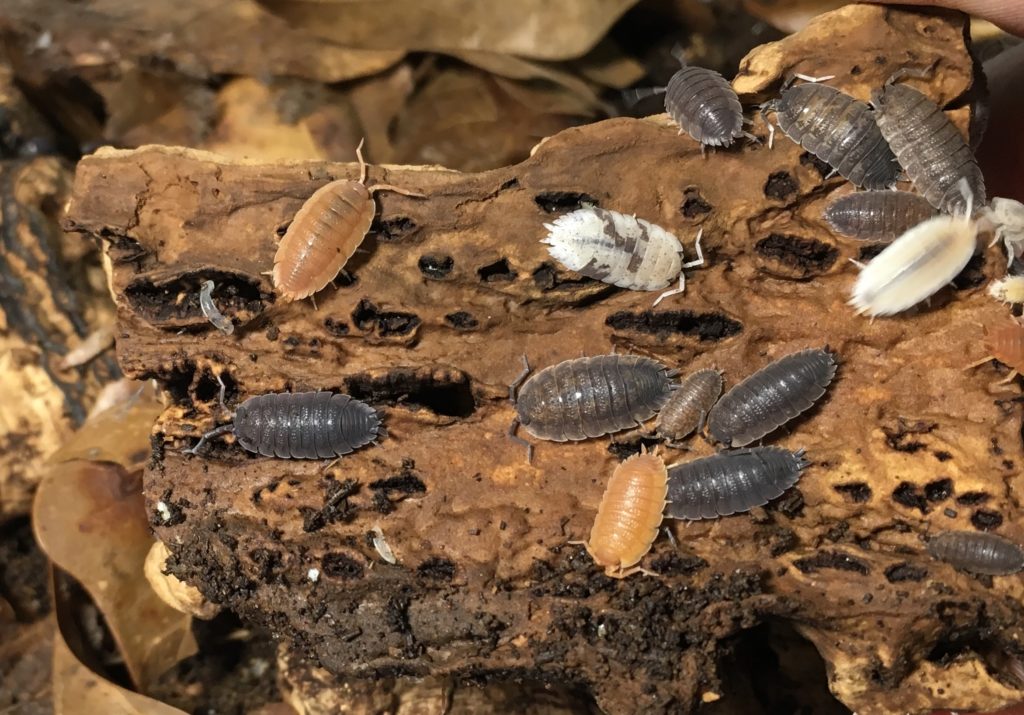
A few years ago, I crossed Porcellio scaber ‘Dalmatian’ with Porcellio scaber ‘Spanish Orange’, replicating what Ryan Orr had already done to create Porcellio scaber ‘Orange Dalamatian.’ I did produce a line of Orange Dalmatians from this cross, but many others also resulted. I kept the others together, and latter introduced a pied specimen or two. Now they are a colorful mix of wild-types, oranges, Dalmatians, Orange Dalmatians, and Calicoes, and possibly some pied specimens.
Porcellio scaber ‘Orange Dalmatian’
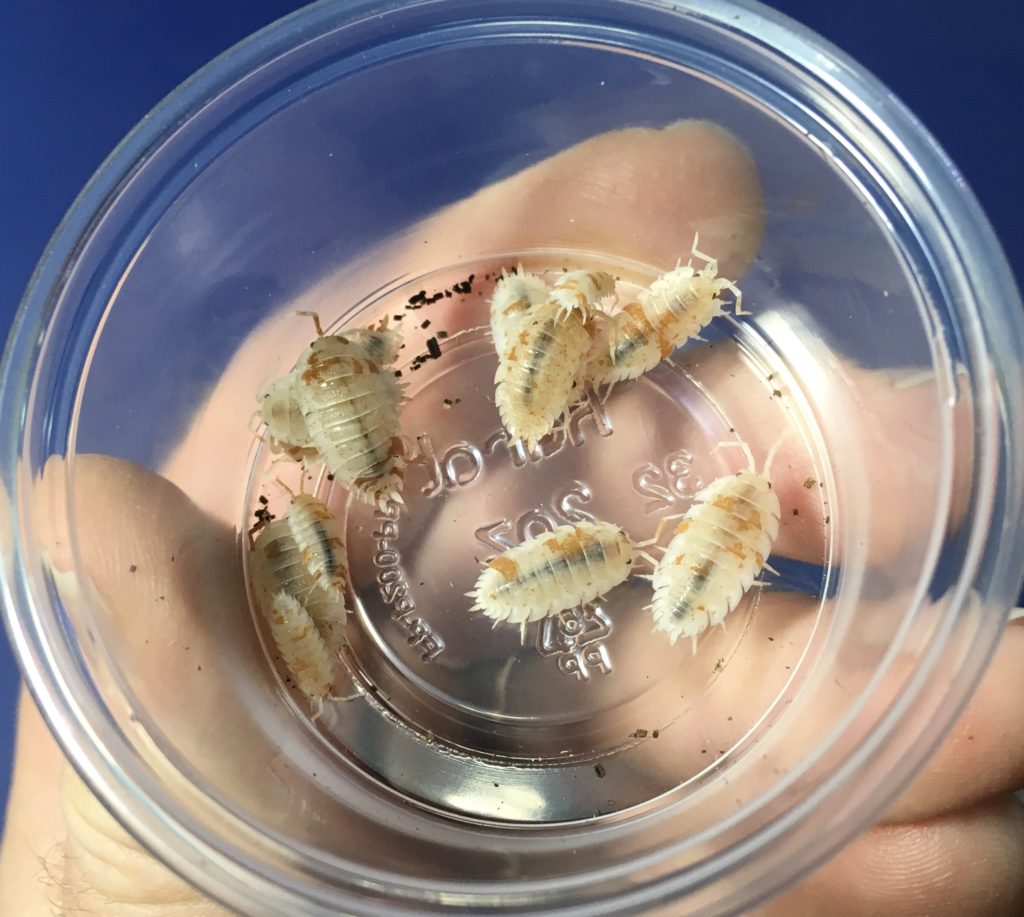
This morph was first created by Ryan Orr, by crossing Porcellio scaber ‘Spanish Orange’ with Porcellio scaber ‘Dalmatian’. The resultant offspring looked just like wild types, but the next generation yielded a few orange Dalmatians. I replicated Ryan’s experiment, and then later obtained some orange Dalmatians from his line, so these are descended from both. I am still finding some normal Dalmatians in this group. Just like the Dalmatians, there are a number of orange Dalmatians that are nearly all white, and a few that appear entirely white.
Porcellio scaber ‘Spanish Orange’
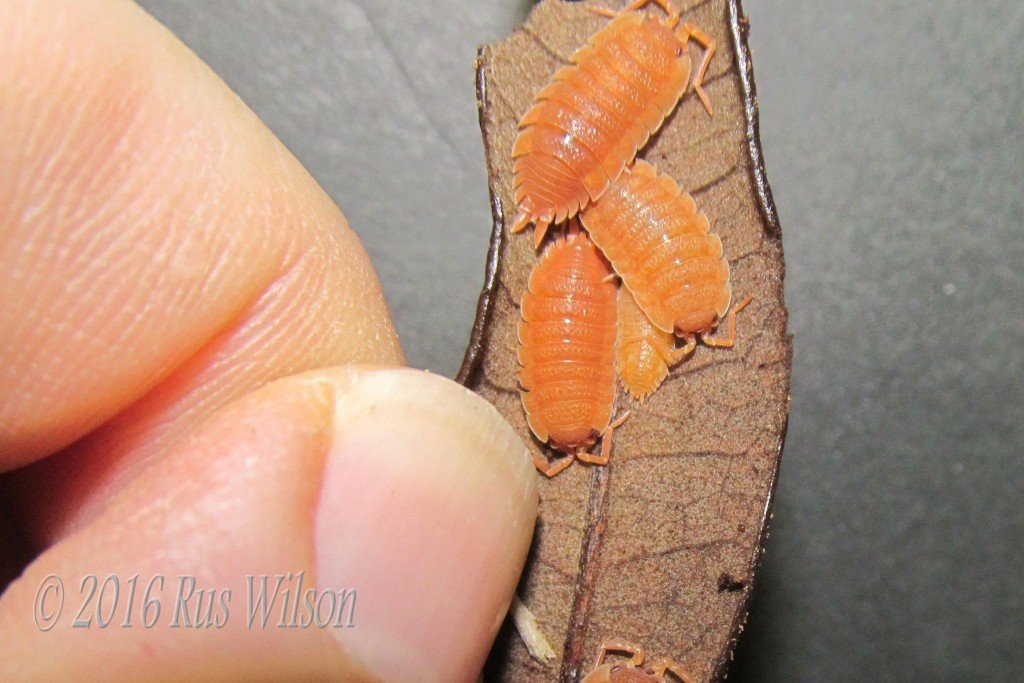
This beautiful orange morph of Porcellio scaber has the distinction of being the first ‘hobby morph’ of isopod, at least as far as I know. In the dart frog hobby it is still sometimes known as the ‘Giant Orange’, as it is so much larger than the tiny tropical species dart frog keepers were used to culturing when this came on the scene. It is now dwarfed, of course, by Porcellio magníficus, among others. Just like the other morphs of P. scaber, this species is tolerant of varying humidity and ventilation levels, is moderately prolific, and has a hearty appetite.
Porcellionides pruinosus (Powder Blue Isopods)
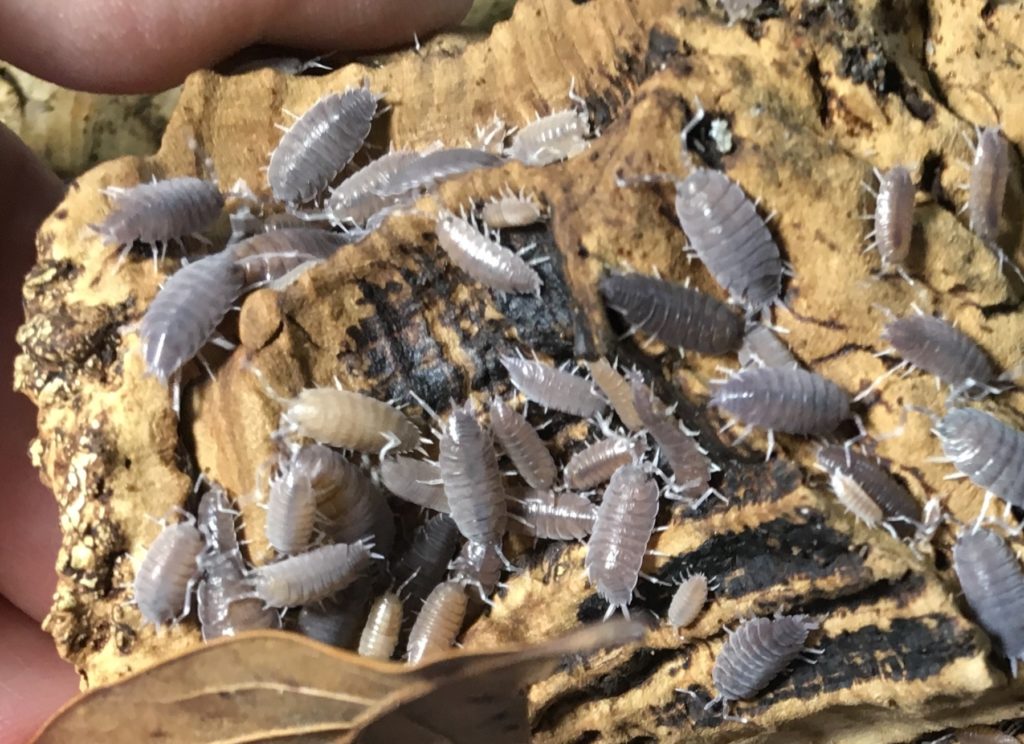
This creatively named species is really more of a silver-gray than a true blue, but it is a nice-looking isopod all the same. Somewhat smaller than Porcellio scaber, this is a fast-moving, highly prolific isopod with a voracious appetite. For an isopod, it is quite tolerant of variations in humidity an ventilation. It even thrives in the rather warm, dry conditions in my bioactive leopard gecko vivarium, although it needs access to a moist hide. These qualities make it one of the best candidates for bioactive vivaria, particularly those that are somewhat on the arid side. I have noticed that this species doesn’t seem to do as well in very humid vivaria with limited ventilation. That said, this is an extremely hardy isopod. It tends to outcompete other species it is kept with.
Porcellionides pruinosus ‘Powder Orange’
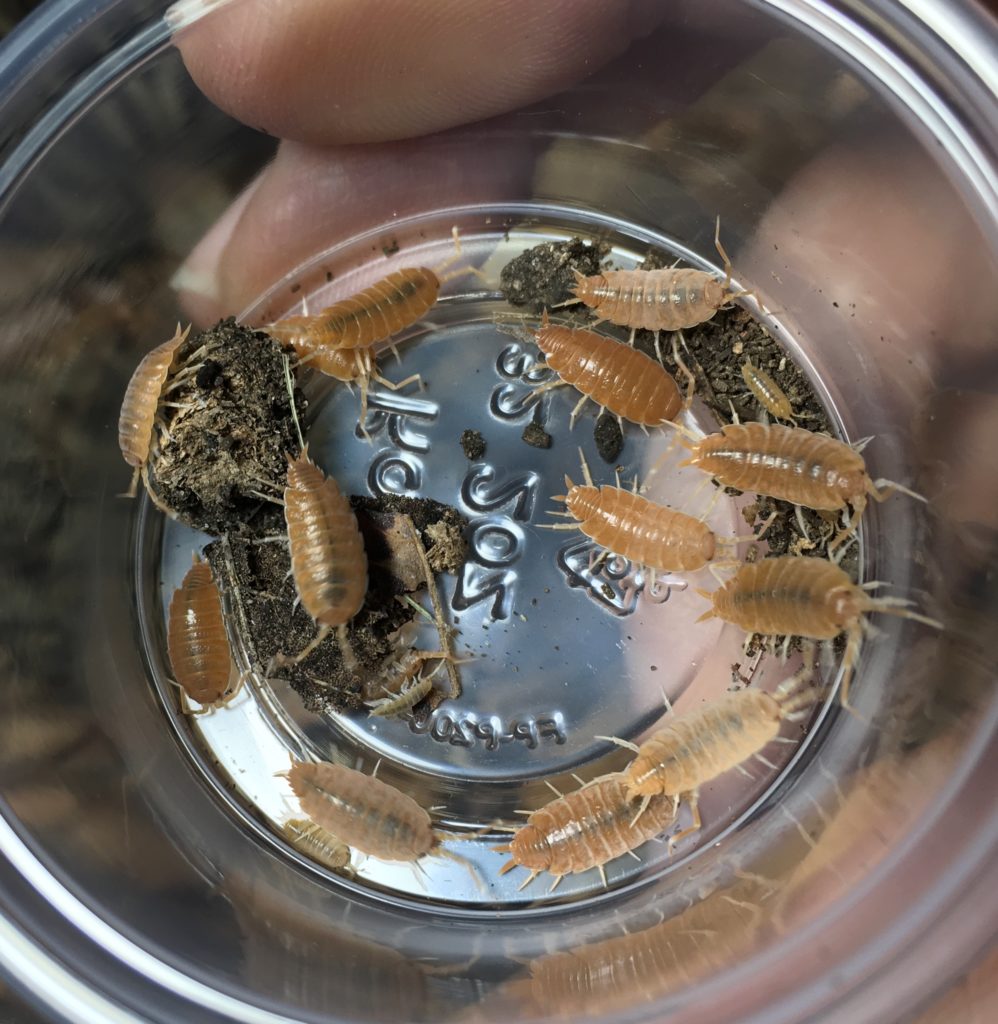
This beautiful velvety orange isopod is a color morph of Porcellionides pruinosus . That being the case, its care and breeding is identical to the powder blue, above, and it makes an equally excellent cleanup crew isopod.
Porcellionides pruinosus ‘White-Out’
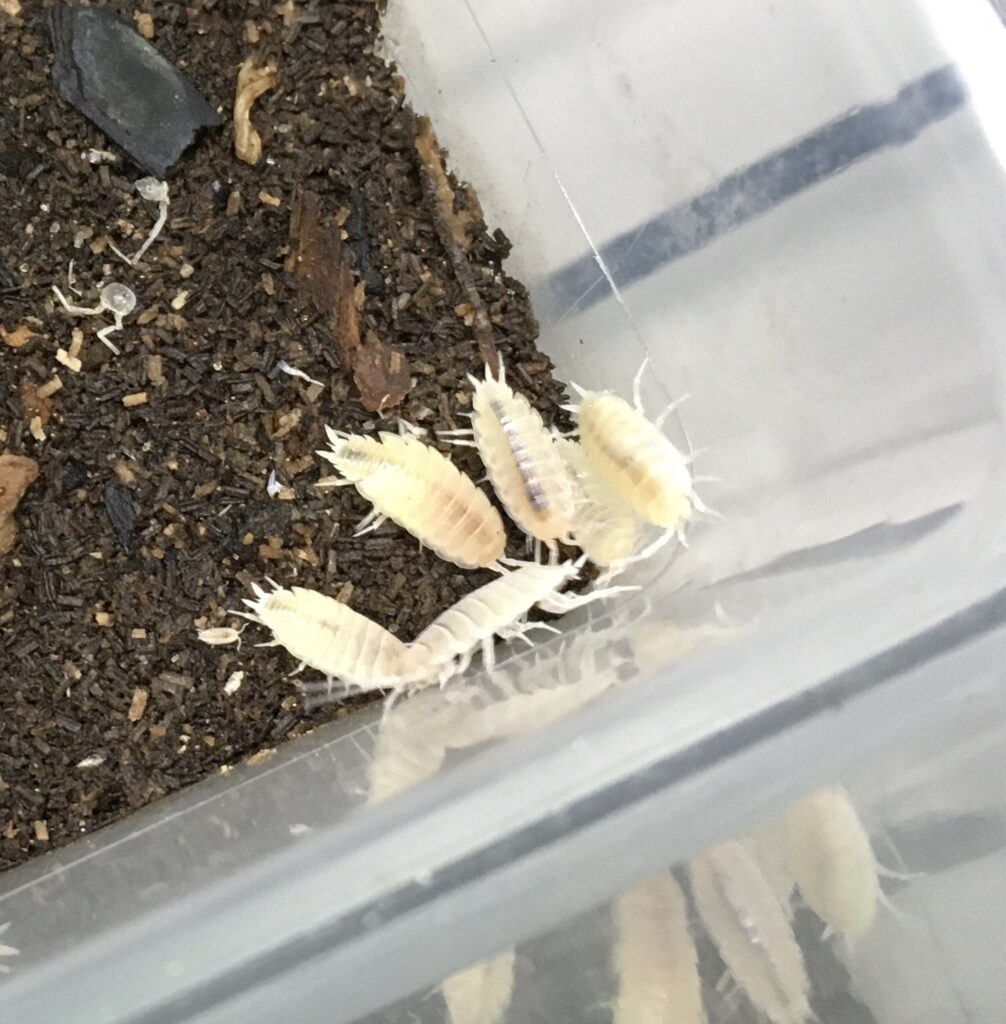
This pale morph of Porcellionides pruinosus is known as ‘White-Out’ for its apparent complete lack of pigment. It is a newer and less common morph of the species, but appears to be just as hardy and prolific an isopod as the wild-type P. pruinosus, or the orange morph.
Trichorina biocellata (Jungle Micropods)
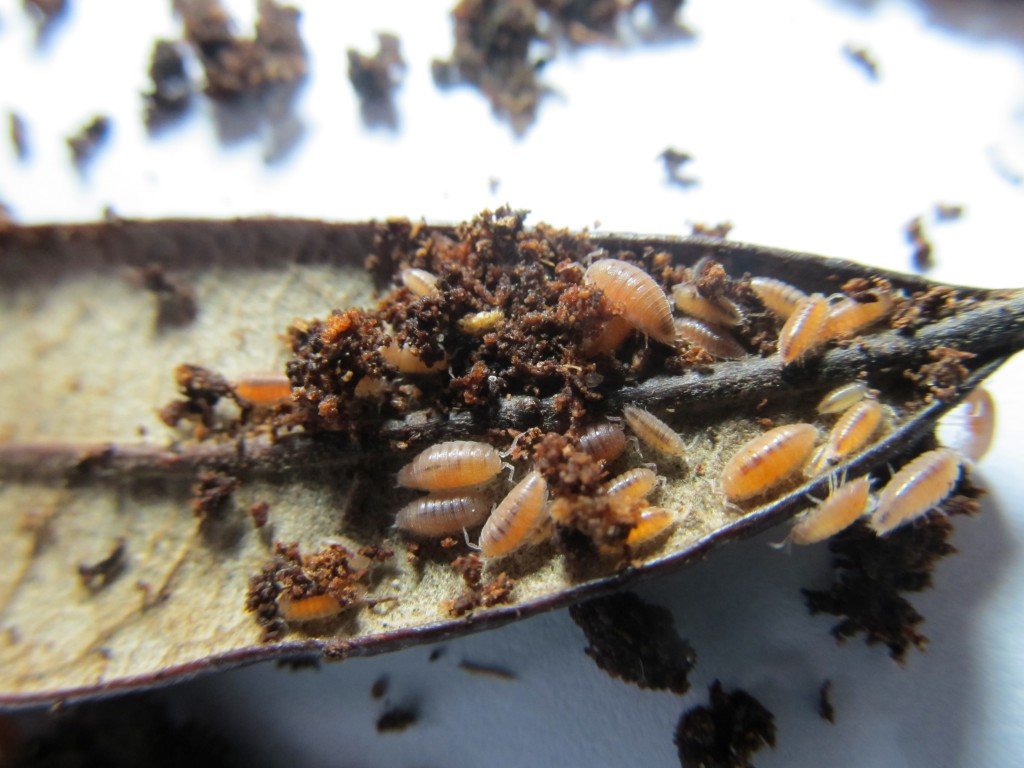
This is the smallest species I keep. They are probably nearly the length of the dwarf whites, but tend to be narrower. Some individuals have a nearly purple tinge to them, while others are more gray. This secretive species tends to hide in the substrate or under other cover, but it makes a good candidate for bioactive vivariums with inhabitants that would be interested in eating larger isopods. For example, I have found that these survive in bioactive vivariums with my mourning geckos where other more conspicuous species, like P. scaber, were eaten.
Trichorhina tomentosa (Dwarf/Micro White woodlice)
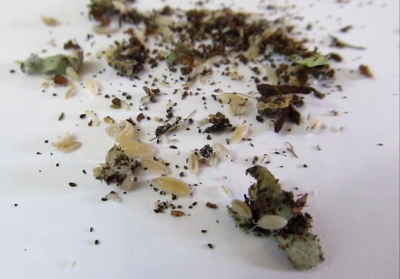
This is one of the first species ever cultured for use in bioactive vivariums. It stays quite small, but it will reproduce quite quickly in good conditions. It prefers higher humidity and does not need a lot of ventilation, making it a good species to keep in tropical and subtropical vivariums, such as those intended for dart frogs. Each individual is a female that produces clones of itself, which helps make the species quite prolific. Warm temperatures (high 70s to low 80s) seem to increase the speed with which it reproduces. Because I need to individually separate these isopods onto paper towels for shipping, I have increased the price at which I sell them.
To learn more about isopod care, visit my Isopod Care page.
Ready to buy isopods? Check out my Stock List.
